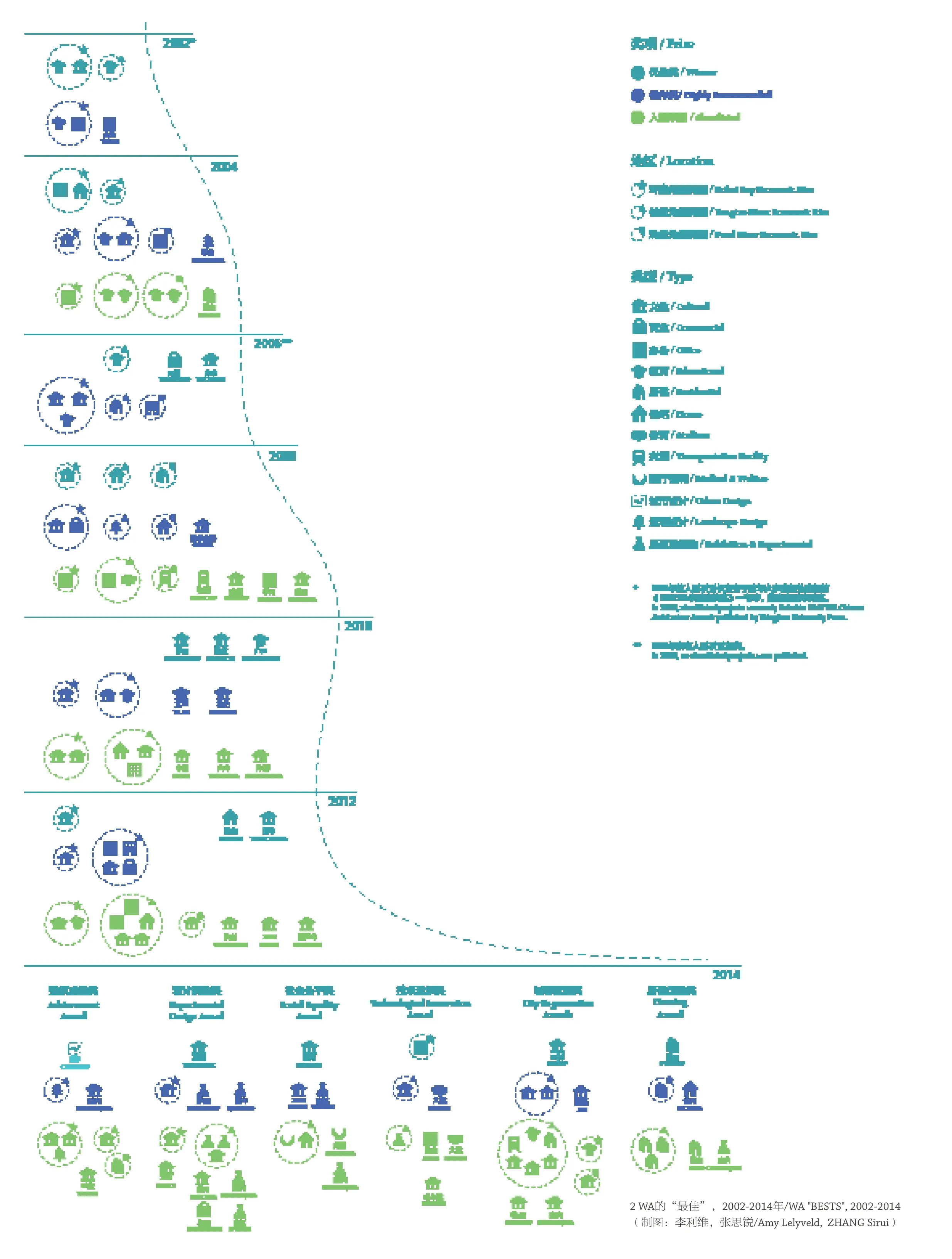构建“最佳”
李利维/Amy Lelyveld
张思锐 译/Translated by ZHANG Sirui
构建“最佳”
Building the "BEST"
李利维/Amy Lelyveld
张思锐 译/Translated by ZHANG Sirui
2002年,《世界建筑》创办了两年一度的WA中国建筑奖奖项,意图选出最优秀的中国建筑,并向中国乃至世界宣传建筑本身、其中包含的观念、建筑的设计者,以及对这个行业的思考。
由此开始,《世界建筑》将这个奖项视为测量行业温度的指标,同时也试图通过诸多来自各个领域的国内外建筑学界或业界评委来引入各式各样“最佳”的概念,并以期扩充话语。
但“最佳”的概念并不牢固。以评选的方式生成的“最佳”既不稳定,也不持久。如同世博会的场馆(一个早期的现代收集佳作和能产生话题的物件的容器),选择的准则、最终对场馆的认可和发出的奖项都是以时间为基准的。这些都是对当下模式的快照(重要但仍然是一张快照),对在这个节点中,什么样的建筑在未来最受到期许的快照。它如同照片一样是一个物化的瞬间。在《世界建筑》中没有差别:奖项的每个片段都对“最佳”有其独特的思考,它是一个每两年都要重建一次的水晶宫。
和其他“建筑”一样,这个“宫殿”也无法逃脱建构的逻辑。在世博会中,沟通的单元是最初的惊鸿一瞥时对每个场馆分别的体验。只有在此之后,各个场馆的内容才开始变得有所关联。在《世界建筑》中,构筑的“最佳”宫殿的砖石是照片。照片是特殊的结构单元:它们被用来竖立在物体的“真实”和期许之间。它们用带着强烈意愿的镜头观察现实、捕捉建筑。
现在,考虑到以上这些,2014的“最佳”宫殿到底是怎样的形状?它又是如何区别于之前的宫殿并标识出我们现今的方位?从2002年到2008年,WA中国建筑奖褒奖了一系列持续凝练的项目。选出的项目在尺度和文化价值上都属于较为重要的类型。它们共同描绘的“宫殿”趋于向心和稳定。从2010年到2012年,虽然获奖的建筑类型基本与前几届一致,但其所涵盖的地理范围和数量都有了很大的提升。项目位置和数量的增加自然而然地产生了变化,为这几年的“宫殿”注入了新的响应力。
2014年的“最佳”宫殿记录了迄今已来最为多样的系统、观点和尺度。“最佳”的屋顶下收集了各种各样的项目,包括在武汉由儿童们在樟树林里建造的树屋、以莫比乌斯环造型并意图表达“经营理念”的北京凤凰中心,以及陕西黄帝陵祭祀区的扩建项目。这些回应的广度再加上2014年各种类别奖项(每一个都是一个自我成立的小宫殿)的出现,暗示了一个为实验和可能性找寻落脚之处的结构。这个多义的模型相比其凝练的前身来说不那么稳定,但是却毫无疑问真实有效。这不恰恰是我们从一开始就期望用来构建这些宫殿的丰富多样性吗?
In 2002 WA began their bi-annual awards, identifying the best in Chinese architecture and broadcasting this-the buildings, the ideas behind them, the people who designed them and the concerns of the profession-to the nation and beyond.
From the start, the magazine situated the awards as a way to regularly take the temperature of the field. And, by including a breadth of opinion about what is best-that of foreign jurors and a spectrum of voices from China's architecture community, both academic and professional-it has hoped to broaden the discourse.
But BEST is slippery. As a designation it is neither static, nor even permanent. As with a worlds fair pavilion (an early modern container for collections of superior and conversation starting objects), the selection criteria, and ultimately the recognition bestowed as awards, are time specific. They are a snapshot (an important one but a snapshot nonetheless) of the pattern of NOW and what-and what kind of building-at this juncture, seems to hold the greatest promise for the future. It is, again like a photograph, the materialization of a moment. At WA it is no different. Each episode of awards builds a unique vision of BEST, a crystal palace that will be rebuilt in two years.
Like other "buildings," the palace built cannot escape the logics of its tectonics. At an expo, the unit of communication is first the WOW and experience of each pavilion. Only after these does what each building contains become relevant. With a BEST palace being built in a magazine, the bricks are photographs. These are special structural units: they are used to erect a position between the "fact" of a thing and its promise. They capture the built using a lens that views the object through its aspirations.
NOW, with all this in mind, what exactly is the shape described by the BEST palace of 2014? And what does how it differs from the palaces that came before tell us about where we are NOW? From 2002 through 2008 the WA Awards lauded a consistently condensed series of projects. The recognized buildings were substantial both in size and cultural value. The "palace" they described as a series was as centered and stable. From 2010 through 2012, while the types of buildings recognized were consistent with earlier years, their geographic range and number increased markedly. The variety that necessarily comes with differences in place and number introduced a new responsiveness into the "palaces" of those years.
The BEST palace of 2014 registers the widest variety of systems, attitudes and even scales yet. The projects collected under the roof of this BEST are as varied as a child-built tree house twisting through a stand of camphor trees in Wuhan, the Mobius gymnastics expressing the "operation concept" of a Beijing Phoenix Center and a the expansion of the sacrifice zone at the Yellow Emperor's Mausoleum in Shaanxi. The breadth of such responses when combined with the new categories possible for awards (each a mini-palace in their own right) suggest a building seeking to make a home for experimentation and possibility. This multi-valent model is less stable than its more condensed predecessors but there is surely real validity to it. Isn't it for the shimmering drama of such a wealth of possibility that we build these palaces in the first place?

1 组装“最佳”的宫殿:1765年沙龙一景,纸上水彩,加布里埃尔·德圣欧班,法国巴黎卢浮宫藏/"BEST" Palace Assembly: View of the Salon of 1765, watercolor on paper, by Gabriel de Saint-Aubin, Musée du Louvre, Paris, France. (图片来源:Erich Lessing /ART RESOURCE N. Y.)

2 WA的“最佳”,2002-2014年/WA "BESTS", 2002-2014(制图:李利维,张思锐/Amy Lelyveld, ZHANG Sirui)
耶鲁大学建筑学院
2015-03-09

